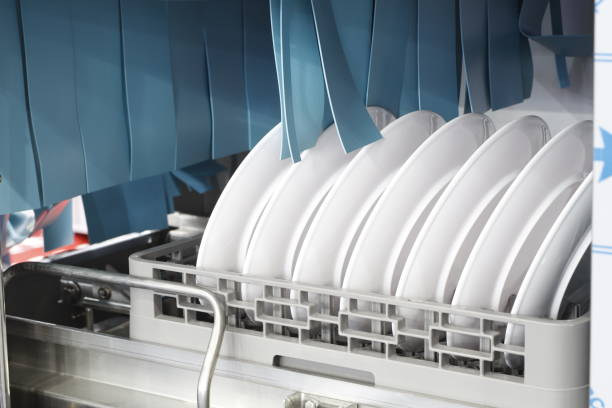Loading a dishwasher properly is crucial for achieving sparkling clean dishes and prolonging the life of your appliance. By following some key steps and utilizing the space smartly, you can ensure that every dish comes out spotless and the dishwasher operates efficiently. This article will guide you through the various steps involved in loading a dishwasher the right way.
Preparing the Dishes
Before you start loading the dishwasher, it’s essential to prepare the dishes correctly. Begin by scraping off excess food debris into the trash or compost bin. There is no need to rinse the dishes thoroughly; modern dishwashers are designed to handle small food particles. However, you should still give them a quick rinse if there are heavy residues. Pre-soaking dishes with baked-on food can also be helpful.
Arranging the Bottom Rack
The bottom rack is generally reserved for larger items such as pots, pans, and plates. Position these items facing the center of the dishwasher where the water spray will be most effective. Place pots and pans at an angle to allow water to reach all surfaces. Ensure that large items do not obstruct the spray arms from rotating freely. Plates should be spaced evenly, with each plate’s dirty side angled towards the dishwasher’s center.
Organizing the Top Rack
The top rack is ideal for smaller and more delicate items. This includes glasses, mugs, small bowls, and plastic containers. To prevent damage, it is crucial to place these items securely. Glasses and cups should be loaded between the tines (prongs) to avoid them tipping over. Ensure taller items do not interfere with the top spray arm. If your dishwasher has foldable tines, adjust them to accommodate larger items.
- Load glasses and cups at an angle to avoid pooling water.
- Use specialized holders for wine glasses and other stemware.
- Mix small bowls and other small items with ample spacing.

Loading the Cutlery Basket
The cutlery basket is a crucial component of the dishwasher that needs to be loaded correctly to ensure all utensils are properly cleaned. Mix knives, forks, and spoons to avoid nesting, which prevents water from reaching all surfaces. You should place knives with the handles up for safety, but other cutlery can go either way, handle-up or handle-down. If your dishwasher has dedicated slots for cutlery, use them to separate items further and facilitate better cleaning.
Using Detergent and Selecting the Right Cycle
After loading the racks and cutlery basket, the next step is to add detergent and select the appropriate washing cycle. Ensure you use a dishwasher-specific detergent and follow the manufacturer’s instructions for the correct amount. Overloading or underloading detergent can compromise cleaning efficiency. Choose a cycle based on the load’s dirtiness – standard or heavy cycles for heavily soiled dishes and lighter cycles for a routine load. Some modern dishwashers come with eco-friendly options that save water and energy.
Conclusion
Properly loading a dishwasher is essential for ensuring that your dishes come out clean and maintaining your appliance’s efficiency. By preparing your dishes, arranging the bottom and top racks correctly, organizing the cutlery basket, and using the right detergent and wash cycle, you can maximize the cleanliness and longevity of your dishwasher. Follow these steps every time you load your dishwasher to achieve best results and preserve the appliance.
FAQs
1. Do I need to rinse dishes before loading them into the dishwasher?
No, most modern dishwashers are designed to handle small food particles, so pre-rinsing is unnecessary. However, large food residues should be scraped off, and heavily soiled dishes may require a quick rinse.
2. How should I arrange the plates and bowls in the dishwasher?
Plates should be loaded on the bottom rack, facing the center for optimal water spray. Bowls can go on the top rack, spaced out to avoid touching and ensure effective cleaning.
3. Can I put plastic containers in the dishwasher?
Yes, plastic containers can be washed in the dishwasher, but they should be placed on the top rack to avoid heat damage. Look for a dishwasher-safe symbol on the containers.
4. How much detergent should I use in the dishwasher?
You should follow the manufacturer’s instructions on the dishwasher-specific detergent for the correct amount. Overloading detergent can leave residue, while too little might not clean effectively.
5. What cycle should I use for heavily soiled dishes?
For heavily soiled dishes, use a heavy-duty or pots and pans cycle. These cycles use more water, heat, and time to thoroughly clean tough food residues.
